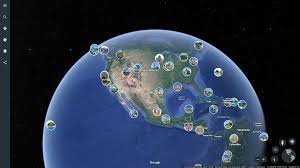Google Earth is a virtual globe that allows users to explore the planet in stunning detail. Launched by Google, it combines satellite imagery, aerial photography, and GIS data to create an interactive 3D experience.
By using your mouse or touchscreen, you can zoom in on any location worldwide. You’ll see everything from city streets to rural landscapes. The platform also provides layers of information about various geographic features and landmarks.
The application works through a combination of vast datasets collected over time. These images are stitched together to form seamless views of our planet’s surface. It even offers tools for measuring distances, creating routes, and viewing historical imagery.
With regular updates and user-contributed content like photos and reviews, Google Earth remains fresh and relevant. Whether you’re exploring familiar neighborhoods or distant countries, the possibilities are endless with this powerful tool at your fingertips.
Benefits of using Google Earth for location tracking
Google Earth offers a wealth of advantages for location tracking. One standout benefit is its stunning visual representation of the globe. You can explore geographical features in detail, from mountains to rivers, providing context that maps often lack.
Another key advantage is accessibility. With just an internet connection, you can dive into detailed satellite imagery from anywhere in the world. This makes it easy to analyze unfamiliar areas or revisit beloved landscapes.
Collaboration is enhanced through shared projects and saved locations. Whether you’re planning a trip or conducting research, sharing your findings with friends or colleagues becomes seamless.
Moreover, Google Earth’s tools allow users to measure distances and elevations accurately. This precision aids in various fields like urban planning and environmental studies, where accurate data matters most.
The integration of 3D visualization elevates your experience even further by offering immersive perspectives on terrain and structures not visible on standard maps.
Step-by-Step Guide to Getting Location by Google Earth
Getting your desired location on Google Earth is simple and intuitive. Start by launching the application or visiting the website.
Once open, look for the search bar in the upper left corner. This is where you type in an address or place name. Hit enter to zoom into that location instantly.
Use the navigation tools on the right side of your screen to explore further. You can tilt and rotate the view for a 3D perspective of buildings and landscapes.
To save a specific spot, click on “Add Placemark” from the toolbar at the top. A pin will drop at your chosen location, which you can rename and customize.
For even more detailed information, utilize layers like roads, borders, and terrain options found in the menu on the left. Enjoy discovering new places with this powerful tool!
Tips and Tricks for Using Google Earth Effectively
To maximize your experience with Google Earth, start by familiarizing yourself with its layers. Turn on the “Borders and Labels” layer for a clearer understanding of country boundaries and city names.
Utilize the search function effectively. Enter specific coordinates or place names to zoom directly into locations of interest, saving you time.
Experiment with different viewing modes like 3D buildings to get a more immersive perspective. This feature can help visualize terrains and urban layouts better than flat images.
Don’t overlook the historical imagery option. It allows you to see how landscapes have changed over time—a fascinating way to explore development patterns or environmental changes.
Take advantage of user-generated content in Google Earth. Check out photos from other users for a richer context about various places around the globe.
Privacy Concerns with Using Google Earth
As exciting as Google Earth can be, it does raise significant privacy issues. Users often overlook how detailed the imagery is. High-resolution satellite images can reveal private properties and even people in their backyards.
Data collection is another concern. Google gathers vast amounts of information from users interacting with its platform. This data contributes to targeted advertising and may be shared with third parties, raising questions about consent.
Moreover, some individuals worry about surveillance implications. The ability to see almost any location on Earth could potentially lead to misuse by malicious actors or government authorities.
While exploring distant landscapes is thrilling, it’s essential to remain aware of what sharing your location might mean for your privacy. Taking steps like adjusting settings and being mindful of personal information can help mitigate these risks while still enjoying the wonders that Google Earth has to offer.
Alternative Options for Location Tracking
If Google Earth doesn’t meet your location tracking needs, there are several alternatives to explore.
Apps like Waze and Google Maps provide real-time navigation and traffic updates. They can pinpoint your exact location while offering route options based on current conditions.
For those focused on outdoor adventures, tools such as AllTrails or Gaia GPS offer specialized mapping features. These apps help hikers track their positions in remote areas where cellular service may falter.
Family locator services present another option. Life360 allows family members to share their locations with one another for added safety and peace of mind.
If privacy is a concern, consider using offline maps or GPS devices that don’t require internet access. These alternatives give you freedom without compromising personal data.
Conclusion
Using Google Earth opens up a world of possibilities for location tracking and exploration. Its powerful tools can help you pinpoint exact locations, explore unfamiliar terrains, or even plan your next adventure with ease. While it offers numerous benefits, such as detailed imagery and satellite views, it’s essential to use the platform mindfully.
Understanding privacy concerns is crucial when engaging with any mapping technology. Balancing these considerations while leveraging the full capabilities of Google Earth can enhance your experience dramatically.
As you navigate this expansive tool, remember that there are also alternative options available if needed. Whether you’re using it for personal exploration or professional tasks, being aware of all aspects will ensure a rewarding journey in discovering our planet’s wonders through Google Earth. Keep exploring!



